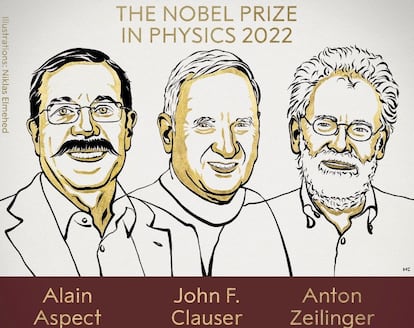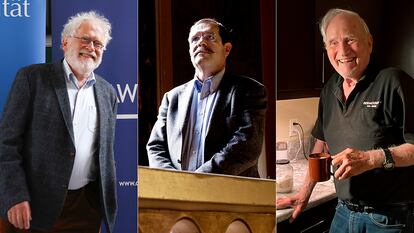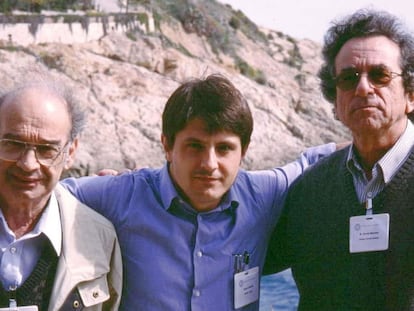Why quantum entanglement is revolutionizing our understanding of nature
The Nobel Prize for Physics recently awarded to Alain Aspect, John F. Clauser and Anton Zeilinger confirms that the natural world really does behave in a strange way

The Royal Swedish Academy of Sciences this year awarded the Nobel Prize in Physics to Alain Aspect, John F. Clauser and Anton Zeilinger for their pioneering work on quantum entanglement, key in the development of new quantum technologies. Their contributions experimentally demonstrated different aspects related to entanglement, such as quantum teleportation or the existence of violations of Bell’s inequalities.
Entanglement is one of the most fundamental and surprising properties of quantum mechanics. It allows two separate particles, even miles apart, to be connected in a way that classical physics cannot explain. Thus, the measurement of a physical property – such as the polarization of a photon – in one of them will determine what is observable in the other, without the existence of any actual physical signals between the two. This anti-intuitive phenomenon led Albert Einstein, Boris Podolski and Nathan Rosen to question, back in 1935, the validity of quantum mechanics as a physical model to describe nature.
Thirty years later, John Bell formalized this intuition of Einstein and his co-authors, showing that from their work one could determine the incompatibility of quantum mechanics with a classical model of nature (known as local hidden-variable theories). Bell’s formalization, fundamental as it was from a conceptual point of view, is surprisingly simple from a mathematical point of view: he proposed a scenario where two people, Alice and Bob, separated in space and each in possession of a particle, perform measurements on these. Alice has several measuring devices and each of these measurements can get different results. The same goes for Bob. After making these measurements a sufficiently large number of times, it will be possible to determine, experimentally, the probability that Alice will obtain a specific result and Bob another, if they have conducted their measurements using specific devices.
In this context, Bell showed that, if the local hidden-variables model is accepted to explain this experiment, those probabilities must satisfy certain mathematical inequalities, since called Bell’s inequalities. Furthermore, Bell proved that, in accordance with the rules of quantum mechanics, in the above scenario Alice and Bob could perform certain measurements on particles that are entangled whose associated probabilities do not meet the stated inequalities. In conclusion, therefore, it is not possible to explain certain experimental probabilities that quantum mechanics predicts by means of a local hidden-variable model.

It is at this point that the winners of the 2022 Nobel Prize in Physics made their contributions. Between 1969 and 1972 John F. Clauser took Bell’s ideas further, simplifying the proposed scenario to adapt it to the experimental capabilities of that time. Then, he carried out the first experiment that confirmed the existence of measurements whose associated probabilities did not verify Bell’s inequalities and, therefore, were not explainable by means of a classical model of nature. Thus it was confirmed that, beyond theoretical reasoning, nature really does behave in a strange way.
However, Clauser’s experiment did not indicate how to deal with certain problems arising from the appearance of errors in the measurements of these experiments. A decade later, Alain Aspect came up with the solution, in what for many years was considered the experiment that really demonstrated the existence of violations of Bell’s inequalities.
These ideas opened the doors to new technologies in computing and cryptography. One of the most surprising phenomena of entangled particles, present in many of the applications of these new technologies, is the ability to transmit all the information from one physical particle to another by sending only a few bits of classic information. This means that quantum information can be sent without a quantum channel being involved in the process. This phenomenon is called quantum teleportation and the third Nobel laureate, Anton Zeilinger, was the first to prove its existence, in 2012, through an experiment that transferred information between two particles separated by a distance of 143 kilometers.
Although from a mathematical point of view, Bell’s work and the different experimental implementations that have been carried out do not present great complexity, the intuition and depth of his ideas have been key in the technological revolution that quantum information theory entails. In addition, the great interest in potential quantum applications in areas as relevant as computing or cryptography has led to a much deeper study of Bell’s inequalities and their possible generalizations. Today these problems are connected to fields such as complexity theory, in computer science, and in Von Neumann algebras, in the field of mathematical analysis.
Carlos Palazuelos is a professor at the Complutense University of Madrid and a member of the Institute of Mathematical Sciences (ICMAT)
Editing and coordination: Ágata A. Timón G Longoria (ICMAT).
Tu suscripción se está usando en otro dispositivo
¿Quieres añadir otro usuario a tu suscripción?
Si continúas leyendo en este dispositivo, no se podrá leer en el otro.
FlechaTu suscripción se está usando en otro dispositivo y solo puedes acceder a EL PAÍS desde un dispositivo a la vez.
Si quieres compartir tu cuenta, cambia tu suscripción a la modalidad Premium, así podrás añadir otro usuario. Cada uno accederá con su propia cuenta de email, lo que os permitirá personalizar vuestra experiencia en EL PAÍS.
¿Tienes una suscripción de empresa? Accede aquí para contratar más cuentas.
En el caso de no saber quién está usando tu cuenta, te recomendamos cambiar tu contraseña aquí.
Si decides continuar compartiendo tu cuenta, este mensaje se mostrará en tu dispositivo y en el de la otra persona que está usando tu cuenta de forma indefinida, afectando a tu experiencia de lectura. Puedes consultar aquí los términos y condiciones de la suscripción digital.










































